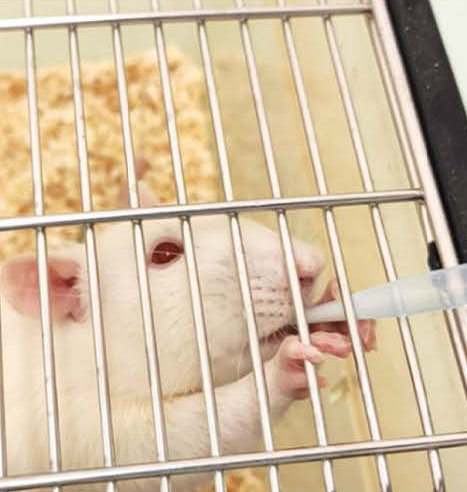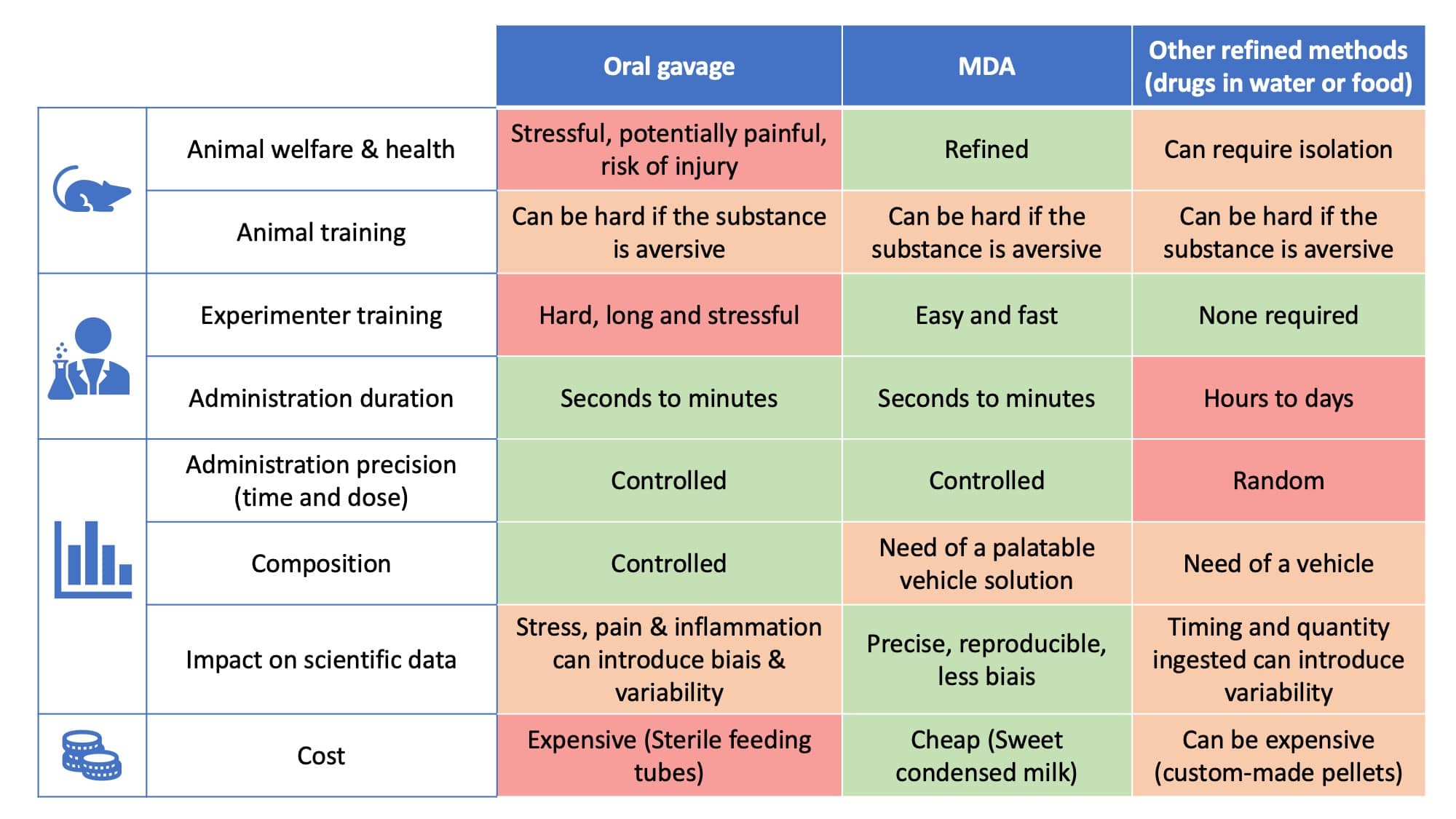
Find out more

Find out more about MDA, in the context of tamoxifen administration in rodents, by attending our webinar on March 13th, at 1pm.
Refining oral treatments in laboratory rodents
Oral administration of substances to laboratory rodents is a common requirement in pre-clinical studies, especially when testing therapeutic compounds intended for oral use in humans.
Traditionally, this is done via oral gavage, a method where a feeding tube is inserted into the animal’s oral cavity and down into the stomach. This forced method, carried on animals that are awake and kept tightly by the neck, can cause a great amount of stress (Stuart and Robinson, 2015), especially if the animal refuses to ingest the unknown substance and struggles. In addition, a repetitive insertion of the cannula or a mis-insertion in the trachea can lead to injury or even death (Brown et al., 2000). Oral gavage remains a gold standard because it enables experimenters to control the dosage and timing of drug administration, while less stressful alternatives - consisting in giving a substance via drinking water (Zhan et al., 2019) or food (Abelson et al., 2012) - do not.
However, for Urs Meyer, a professor at the Institute of Veterinary Pharmacology and Toxicology at the University of Zurich, working on environment-sensitive brain development disorders such as autism and schizophrenia, it was scientifically mandatory to come up with an alternative: regularly administering substances with the stress of oral gavage would have compromised most of their research findings (Taylor et al., 2019). He and his team have thus developed the Micropipette-guided Drug Administration MDA method for rodents (Scarborough et al., 2020), which allows animals to ingest active substances voluntarily and without risk of injury, via a palatable solution.
MDA and its various advantages
Pr Meyer’s method consists in offering the mice a diluted sweetened condensed milk solution using a conventional micropipette, and after a short period of habituation and minimal training time, they drink it voluntarily:
-
Day 1: mice are held by the neck, but instead of using a cannula, a micropipette filled with diluted sweet condensed milk is brought to its mouth to deliver a taste of the solution, which they drink
-
Day 2: mice are placed on top of the cage and simply held by the tail while encouraged to drink directly from the pipette
-
Day 3: mice drink voluntarily without any physical restraint.
After this habituation and training, it is then possible to add drugs of interest to the solution and start experimenting.
In rats, habituation takes up to 7 days: 3 days during which the diluted sweet condensed milk is placed in a small cup in the cage, to familiarize them with the solution, and 4 days for which the solution is proposed with a micropipette through the bars of their cage (Heraudeau et al., 2023).

By allowing a completely safe and stress-free oral administration of substances, MDA presents a huge Refinement for animals. As it is easier to learn and perform than the gavage technique, less stressful, more agreeable and cheaper, the MDA also benefits experimenters (researchers and animal technicians) and allows them to have better interactions with the animals and to gain time, especially for long studies (Heraudeau et al., 2023).
This method also has the potential to increase scientific robustness and reproducibility - which can help Reducing the number of animals required for an experiment - by being more precise and repeatable (a micropipette is more precise than a gavage syringe), and by removing the major bias introduced by stress, pain or inflammation (Heraudeau et al., 2023).

Growing Applications of MDA
The MDA method has already been successfully applied in mice for different drugs and fields of research (Iovino et al., 2022), tamoxifen-mediated gene recombinaison (Vankecke et al., 2023) and vaccination (Chamorro et al., 2023). It has also been successfully used with rats, and showed to be faster than oral gavage, with no effects of the sweet vehicle on body weight or glycemia even after weeks of treatment (Heraudeau et al., 2023).
However, as it remains important to scientifically validate the MDA for it to become the new gold-standard for oral drug administration in rodents, the “Rodent MDA” project, funded by the Swiss NRP79 "Advancing 3R - Animals, Research and Society", is collecting scientific data from various research fields to show the efficacy and limitations of the method to the scientific community. To this end, Dr Meyer’s and Dr Johansen’s (University Hospital Zurich) teams are studying and comparing vehicle solutions and applications ; they are working, for example, on developing new vehicles for very bitter substances, on optimizing the method for metabolic studies (as each individual component of condensed milk can affect the measurements), and on getting MDA approved for the administration of pain killers.
Get Trained on MDA
The MDA method is promoted online via a website and social media, to which new training material is regularly added. The standard operating procedure (SOP) for the MDA is available in English and French. In order for experimenters worldwide to learn and apply the method correctly, meetings, workshop and training opportunities in Europe are also possible : rodentmda@uzh.ch
This advantageous new method of oral administration in rodents has the potential to replace gavage in many areas of research. Closer to the clinical reality, it is even more valuable when oral administration has to be performed chronically. It appears important to adapt and validate it to various fields of research, so that the gavage procedure should only be used as an alternative in cases where MDA did not work.
